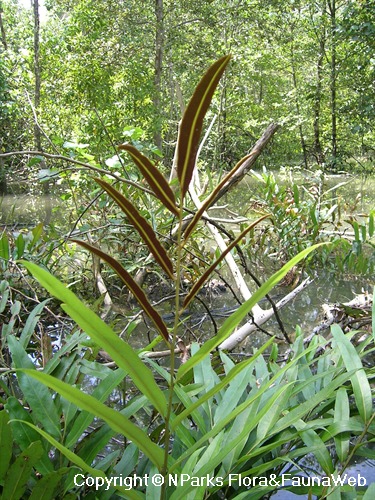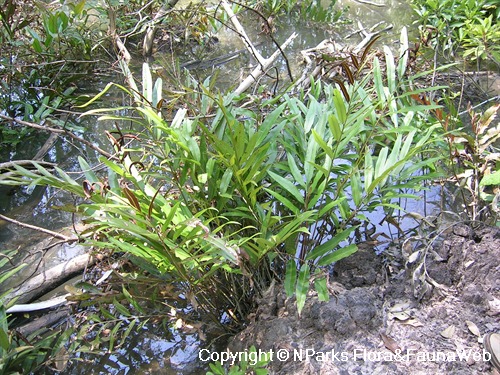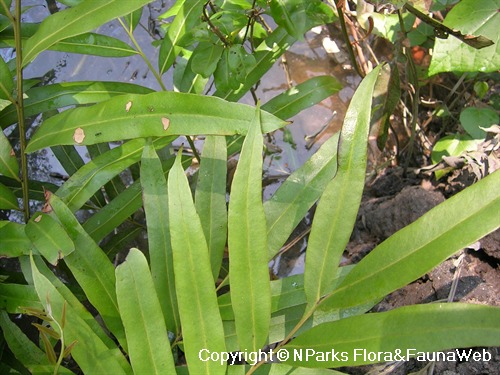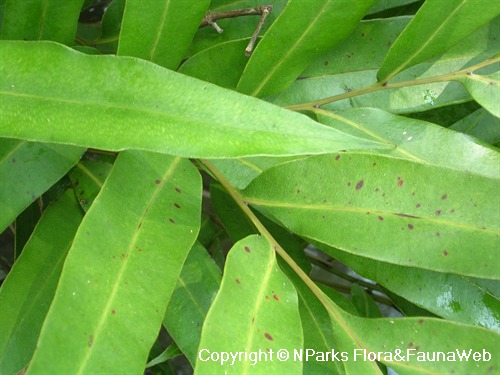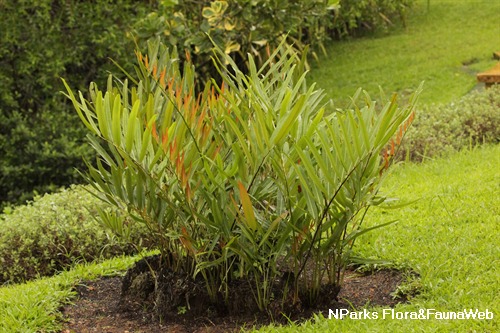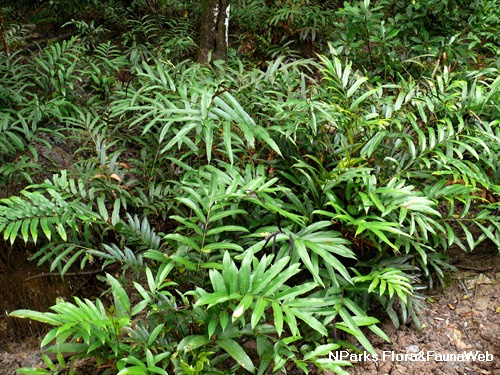
Name
Classifications and Characteristics
| Plant Division | Ferns & Lycophytes (Non-Seed Vascular Plants) (Fern) |
|---|---|
| Plant Growth Form | Herbaceous Plant, Aquatic & Hydrophyte (Waterside / Marginal) |
| Lifespan (in Singapore) | Perennial |
| Mode of Nutrition | Autotrophic |
| Maximum Height | 2 m |
Biogeography
| Native Distribution | Tropical Asia & Australia |
|---|---|
| Native Habitat | Shoreline (Mangrove Forest) |
| Preferred Climate Zone | Tropical |
| Local Conservation Status | Native to Singapore (Least Concern (LC)) |
Description and Ethnobotany
| Growth Form | Tall fern that grows in large, dense clumps. |
|---|---|
| Foliage | Large fronds are pinnately compound (up to 2 m long). The opposite pinnae are oblong with a sharply pointed tip (15 cm long). The fertile pinnae are smaller than the sterile ones and form dark brown sporangia that cover the entire underside. |
| Stems | It has an underground, horizontal stem known as a rhizome. The rhizome and the base of the stipes (frond petioles) are covered in shiny, dark brown scales (8 mm long). |
| Habitat | Occurs mostly in brackish, sometimes in freshwater, swamps, marshes and tidal forests. In mangroves, often found deep within inland regions. |
| Associated Fauna | The Purple Heron (Ardea purpurea) prefers to nest at the base of this species. Sometimes grows on Mud Lobster mounds. |
| Ethnobotanical Uses | Medicinal: The rhizome (underground, horizontal stem) is crushed and applied to wounds and boils. |
Landscaping Features
| Desirable Plant Features | Ornamental Foliage |
|---|---|
| Landscape Uses | Riverine, Pond / Lake / River, Marsh / Bog |
| Thematic Landscaping | Marsh Garden |
Plant Care and Propagation
| Light Preference | Semi-Shade, Full Shade |
|---|---|
| Water Preference | Lots of Water |
| Plant Growth Rate | Moderate |
| Rootzone Tolerance | Waterlogged Soils (Drains Site) |
| Propagation Method | Spore, Division |
Foliar
| Foliage Retention | Evergreen |
|---|---|
| Mature Foliage Colour(s) | Green |
| Mature Foliage Texture(s) | Smooth, Glossy / Shiny |
| Foliar Type | Compound (Odd-Pinnate) |
| Foliar Attachment to Stem | Petiolate |
| Foliar Shape(s) | Non-Palm Foliage (Oblong) |
| Foliar Venation | Pinnate / Net |
| Foliar Margin | Entire - Wavy / Undulate |
| Foliar Apex - Tip | Acuminate |
| Foliar Base | Rounded / Obtuse |
| Typical Foliar Area | Macrophyll ( 182.25cm2 - 1640.25 cm2 ) |
References
| References | Yong J, Tan PY, Nor Hafiz Hassan, Tan SN. 2010. A Selection of Plants for Greening of Waterways and Waterbodies in the Tropics. Singapore: Chung Printing . 480 pp. |
|---|
Image Repository
Others
| Master ID | 240 |
|---|---|
| Species ID | 1536 |
| Flora Disclaimer | The information in this website has been compiled from reliable sources, such as reference works on medicinal plants. It is not a substitute for medical advice or treatment and NParks does not purport to provide any medical advice. Readers should always consult his/her physician before using or consuming a plant for medicinal purposes. |

